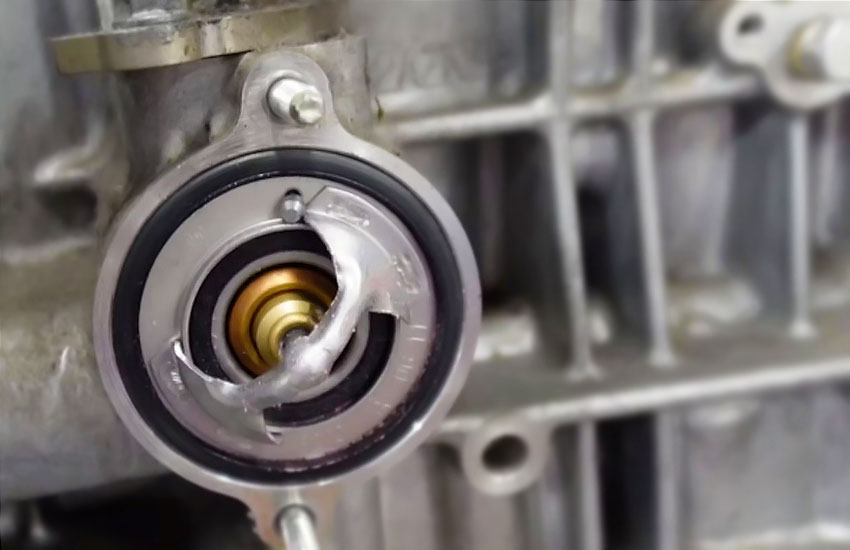You might be wondering what happens if you remove your car thermostat. It sounds a bit strange, but it’s something some people consider. The thermostat helps control the engine temperature by keeping it at a steady level. Removing it can make your car run cooler, which might seem like a good thing.
But there are some downsides too. It can make your engine work harder, reduce fuel efficiency, and even cause other issues over time. In this post, we’ll look at what happens when you remove the thermostat, the benefits some people see, and the possible problems you might face.
Effects of Removing Your Car Thermostat
Removing a car thermostat can have some big effects on how your car runs. The thermostat is a small part in your engine that helps control its temperature. Without it, your engine might not work as well. Let’s look at how this change can affect your car in different ways.
Engine Temperature Changes
The main job of the thermostat is to keep the engine at the right temperature. Without it, the engine can get too hot or too cold. When the engine is too cold, it doesn’t run smoothly and uses more fuel. If it gets too hot, it might even get damaged.
Engine Performance
Without a thermostat, your engine might not perform as well. It could run rough or feel sluggish because the engine is not at the ideal temperature. This can affect how your car drives and how well it accelerates.
Fuel Efficiency
A car engine needs to be at the right temperature to use fuel efficiently. Without a thermostat, the engine might use more fuel than usual. This means you’ll need to fill up your tank more often, which can cost you more money.
Emissions and Pollution
Engines that don’t run at the right temperature can produce more pollution. This is because the engine isn’t burning fuel as cleanly as it should. Removing the thermostat can lead to higher emissions, which is bad for the environment and might make your car fail emissions tests.
Risk of Overheating
Without the thermostat to control the engine temperature, there’s a risk that your engine could overheat. Overheating can cause serious damage, like a cracked engine block or a blown head gasket. These repairs can be very expensive.
Engine Longevity
If your engine often runs too hot or too cold, it can wear out faster. This means you might have to deal with more breakdowns and repairs over time. Keeping the thermostat in place helps the engine run smoothly and last longer.

Benefits of Removing a Car Thermostat
Removing a car thermostat isn’t common, but some people do it for specific reasons. The thermostat helps control the engine’s temperature, but in certain situations, taking it out might be helpful. Let’s look at some possible benefits of removing a car thermostat.
Quicker Engine Warm-Up
Without a thermostat, the coolant flows through the engine constantly. This can help the engine warm up faster, especially in cold weather. Some people remove the thermostat to make sure the engine heats up more quickly when they start their car.
Avoiding Overheating in Hot Climates
In very hot climates, an engine can sometimes overheat because the thermostat might not open fast enough to cool it down. Removing the thermostat can keep the coolant flowing freely, helping to prevent overheating in extremely hot conditions.
Simplified Cooling System
Without a thermostat, the cooling system becomes simpler. There’s one less part to worry about failing or getting stuck. This can make maintenance a bit easier because you don’t have to check or replace the thermostat.
Potential Performance Boost
In some high-performance cars or modified engines, people remove the thermostat to keep the engine cooler at all times. A cooler engine can sometimes perform better, especially during heavy use like racing or towing. This can give the engine a bit more power when it’s needed the most.
Reducing Engine Wear in Some Cases
In certain situations, like when an engine is already running very hot, removing the thermostat might reduce wear and tear. By keeping the engine cooler, there’s less stress on the engine parts, which might help them last longer.
Easier Troubleshooting
If you’re having problems with your car overheating, removing the thermostat can help you figure out if it’s the cause. Without the thermostat, you can see if the engine still overheats. If it doesn’t, the thermostat might have been the problem. This can make diagnosing issues simpler.
It might help the engine warm up faster, prevent overheating in hot climates, and simplify the cooling system. However, it’s important to weigh these benefits against the potential risks before deciding to remove the thermostat from your car.
Drawbacks of Removing Your Car Thermostat
While removing a car thermostat might seem like a good idea in some situations, it can actually cause several problems. The thermostat plays a key role in keeping the engine at the right temperature, and without it, your engine might not work as well. Let’s explore some of the drawbacks of removing a car thermostat.
Engine Runs Too Cold
Without a thermostat, the engine might not reach its optimal temperature. When an engine runs too cold, it doesn’t work as efficiently. This can make your car feel sluggish and less responsive, especially when you need to accelerate. A cold engine also uses more fuel, which means you’ll spend more money on gas.
Increased Fuel Consumption
A cold engine burns fuel less efficiently, leading to increased fuel consumption. Without the thermostat, the engine might take longer to warm up, or it might never reach the right temperature. This means you could be using more fuel than necessary every time you drive, which isn’t good for your wallet or the environment.
Higher Emissions
Engines that don’t reach the proper temperature produce more emissions. This happens because the engine isn’t burning fuel as cleanly as it should. Increased emissions are not only harmful to the environment but could also cause your car to fail emissions tests. This can lead to fines or the need for costly repairs to get your car back in compliance.
Risk of Overheating
The thermostat helps regulate the engine’s temperature by controlling the flow of coolant. Without it, there’s a risk that the engine could overheat, especially in hot weather or during heavy use. Overheating can cause serious damage to the engine, such as a cracked engine block or a blown head gasket. These issues are expensive to fix and could leave you stranded.
Engine Wear and Tear
Running the engine at the wrong temperature can cause increased wear and tear. Parts of the engine might wear out faster if they are constantly exposed to temperatures that are too hot or too cold. This could lead to more frequent breakdowns and costly repairs, shortening the lifespan of your engine.
Poor Cabin Heating
The thermostat also helps control the flow of hot coolant to the car’s heater core, which warms up the cabin. Without it, the engine might not get hot enough to produce adequate heat for the interior of the car. This can make for uncomfortable drives, especially in cold weather.
There’s also a risk of overheating and increased engine wear, not to mention poor heating inside the car. Overall, it’s usually better to keep the thermostat in place to avoid these issues.
Are these Questions in Your Mind?
Is it safe to drive without a car thermostat?
Driving without a thermostat can be risky because your engine might not reach the right temperature, which can lead to poor performance, higher fuel consumption, and increased wear on the engine parts.
Can removing the thermostat cause engine damage?
Yes, removing the thermostat can cause engine damage if the engine overheats or runs too cold. Overheating can lead to serious issues like a blown head gasket, while running too cold can increase wear on the engine.
Is it necessary to remove the thermostat in hot weather?
It’s not usually necessary to remove the thermostat in hot weather. Modern thermostats are designed to handle a wide range of temperatures and should work well even in very hot climates.
Can removing the thermostat improve engine performance?
In some cases, removing the thermostat might slightly improve performance, especially in high-performance engines. However, for most vehicles, the risks outweigh the potential benefits.
Do I need to replace the thermostat regularly?
No, thermostats don’t need to be replaced regularly. They should be replaced if they fail or if you’re doing major cooling system work, but otherwise, they can last the life of the vehicle.
Is it okay to remove the thermostat if my car keeps overheating?
It’s not recommended to remove the thermostat if your car is overheating. Overheating can be caused by other issues like a failing water pump or a clogged radiator. It’s better to fix the root cause rather than removing the thermostat.
Can I remove the thermostat myself?
Yes, you can remove the thermostat yourself if you have basic mechanical skills. However, it’s important to know that this is usually not recommended unless you’re troubleshooting a specific issue.
Do I need a thermostat in a warm climate?
Yes, even in a warm climate, the thermostat is important. It helps the engine reach the right operating temperature quickly and keeps it there, which is essential for good performance and fuel efficiency.
Is it better to use a lower-temperature thermostat instead of removing it?
Using a lower-temperature thermostat can be a better option than removing it altogether. This allows the engine to run cooler without the risks associated with removing the thermostat.
Can removing the thermostat affect my car’s warranty?
Yes, removing the thermostat could void your car’s warranty if it leads to engine damage or other problems. It’s always best to check your warranty terms and consult with a professional before making such changes.
I hope you found this helpful! Removing a car thermostat might seem like a quick fix, but it can cause more problems. While it might help a bit in hot weather, it can make the engine run too cool, leading to poor performance and more wear. It’s usually better to fix the problem properly instead of removing the thermostat.


